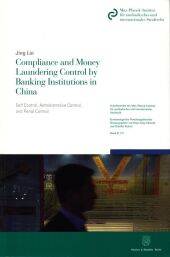 Neuerscheinungen 2017Stand: 2020-02-01 |
Schnellsuche
ISBN/Stichwort/Autor
|
Herderstraße 10
10625 Berlin
Tel.: 030 315 714 16
Fax 030 315 714 14
info@buchspektrum.de |

Jing Lin
Compliance and Money Laundering Control by Banking Institutions in China.
Self Control, Administrative Control, and Penal Control. Dissertationsschrift
2017. XVI, 222 S. 22 Tab., 11 Abb.; XVI, 222 S. 224 mm
Verlag/Jahr: DUNCKER & HUMBLOT 2017
ISBN: 3-428-15034-1 (3428150341)
Neue ISBN: 978-3-428-15034-2 (9783428150342)
Preis und Lieferzeit: Bitte klicken
Is criminal law an effective instrument to control corporate crime? Do alternative control instruments exist? Is it possible to conduct corporate compliance programs in developing economies? Are Western-developed control theories applicable in other regions? Using money laundering control in Chinese banking institutions as an example, this book provides answers to these questions.
Is criminal law an effective instrument to control corporate crime? Do alternative control instruments exist? Is it possible to conduct corporate compliance programs in developing economies? Are Western-developed control theories applicable in other regions? Using money laundering control in Chinese banking institutions as an example, this book provides answers to these questions.
Three severity escalated control systems, i.e., self-control, administrative control, and penal control, are introduced by the author, and the legal framework of each of these approaches - as well as their practical advantages and limitations - are observed. The author concludes that none of the individual control instruments are, on their own, capable of successfully controlling corporate crime and promoting compliance. Control instruments are interdependent, meaning that each is incomplete without the other. Therefore, a comprehensive control approach that includes persuasive strategies and deterrence strategies is essential for sound compliance. In addition to the involvement of various control instruments, a comprehensive approach also requires proper linkage between these instruments.
To answer the critical question of when to take a persuasive strategy and when to take a deterrence strategy, the author proposes a "distinction approach". This would abandon the model of "one size fits all" and underline various distinctions that should be given special attention in choosing control instruments.
Chapter 1: Introduction
Problem Statement - Research Design
Chapter 2: Background
General Situation of Money Laundering and its Control in China - Overview of China´s Banking Industry - Money Laundering/Anti-money Laundering and Banking Sector
Chapter 3: Internal Control
The Concept of Internal Control - Framework of Internal Control Regulatory - Compliance Culture and Policy - Compliance Organization - Procedure - Conclusion
Chapter 4: Administrative Approach
The Concept of Administrative Control - Persuasive Approach - Punitive Approach - Advantages and Limitations of the Administrative Approach as Control Instrument
Chapter 5: Penal Approach
The Concept of the Penal Approach - Corporate Criminal Liability Arrangements - Criminal Measures against Anti-money Laundering Non-compliance - Deterrent Effect of the Penal Approach - Advantages and Limitations of the Penal Approach as Control Instrument
Chapter 6: Linkage
Practical Perspective - Theoretical Analysis - "Distinction Approach"
Chapter 7: Conclusion
References


